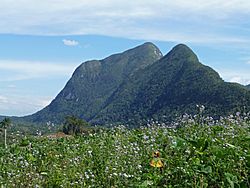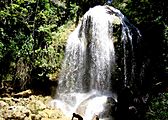Guaniguanico facts for kids
Quick facts for kids Guaniguanico |
|
|---|---|
| Cordillera de Guaniguanico | |

Viñales Valley, part of the cordillera
|
|
| Highest point | |
| Peak | Pan de Guajaibón |
| Elevation | 699 m (2,293 ft) |
| Dimensions | |
| Length | 160 km (99 mi) |
| Geography | |
| Country | Cuba |
| Range coordinates | 22°43′19″N 83°28′48″W / 22.72194°N 83.48000°W |

The Guaniguanico (also known as Cordillera de Guaniguanico) is a mountain range in western Cuba. It stretches across parts of the Pinar del Río Province and the Artemisa Province. This range is made up of two smaller mountain groups: the Sierra del Rosario and the Sierra de los Órganos.
Contents
What's in a Name? (Etymology)
The name Guaniguanico has an interesting history. Experts like Granberry and Vescelius (2004) think it comes from the ancient Guanahatabey language. This language was spoken by early people in Cuba.
They compare it to the word wani-wani-ku from the Warao language. The Warao language is spoken in the Orinoco Delta. Wani-wani-ku means 'hidden moon' or 'moon-set'.
Where is Guaniguanico? (Geography)
This mountain range is about 160 kilometers (100 miles) long. It starts near the town of Guane in the west of Pinar del Río Province. It then goes all the way to the Alturas de Mariel, which is close to Mariel in Artemisa Province.
The Guaniguanico range is split into two main parts. The Sierra de los Órganos is on the western side. The Sierra del Rosario is on the eastern side. The San Diego River (also called Río San Diego) flows between these two sections.
The tallest point in the Guaniguanico range is Pan de Guajaibón. This mountain is 699 meters (2,293 feet) high. It is located between the towns of Bahía Honda and La Palma. Pan de Guajaibón is a well-known symbol of western Cuba.
Amazing Places to Visit
The Guaniguanico mountain range is home to many beautiful and important places.
One of the most famous is the Viñales Valley. This valley is a natural reserve. It is also a World Heritage Site, recognized by UNESCO for its special beauty and culture.
Other cool spots include the Salto de Soroa waterfalls. There's also the nature reserve called Las Terrazas. Another protected area is known as Mil Cumbres. These places offer stunning natural views and chances to explore.
See also
 In Spanish: Cordillera de Guaniguanico para niños
In Spanish: Cordillera de Guaniguanico para niños
- Geography of Cuba




